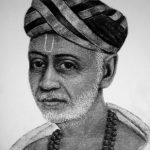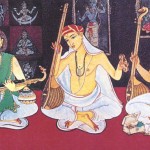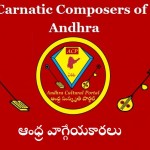The following post was composed by Ashok Madhav garu, vaggeyakara.
Readers may be familiar with our Personalities article on the mighty composer, Thyagaraja. This post supplements the biography, but focuses primarily on Thyagayya’s long term impact on the Carnatic tradition, and the music itself.
Brief History of Thyagaraja Swami
Thyagaraja Swami, is one of the Trinity of Carnatic Music and others being Syama Sastri and Muthuswami Dikshitar. He was born in 1767 in Tiruvarur, Tamil Nadu and lived his entire life in Tiruvaiyaru, also in Tamil Nadu. His parents were Telugus named Sitamma and Ramudu as has been recorded in one of his songs, “Sitamma mayamma Sri Ramudu Madu tandri “. He belongs to the Kakarla vamsa. He briefly learnt music from Sonti Venkataramanaiah. He was a prolific composer and his compositions are mostly in Telugu and some in Sanskrit. He was a great devotee of Lord Rama and many of his compositions are on Lord Rama. While in Tiruvaiyaru, he visited several temples in Kancheepuram, Tirupati, Srirangam, Kovvuru (near Chennai) , Lalgudi and Tiruvottiyur and composed kritis in praise the presiding deities of those Temples.
All his compositions were full of bhakti and bhavam and so they become popular and naturally his fame spread all around. The Maharaja of Thanjavur wanted him to be the Royal court musician. Thyagaraja declined the offer by singing a kriti “Nidhi chala sukhama”. Thyagraja swami is supposed to have composed several hundreds of compositions, but only about 700 of them are available now. He developed several new ragams and his compositions are the only ones set in those rare ragams. One outstanding feature of Thyagaraja swami’s compositions is inherent scope for developing sangathis (i.e.: ‘Dorakuna itu vanti’ (Bilahari) and ‘Darini telusukonti’ (Shuddha saveri).) Sangathi is a variation in the line of a melody. Specifically, this occurs when a composer intends for the Pallavi to be sung differently at different points in the kriti.
Music scholars eulogise Thyagaraja swami’s compositions for their musical and technical greatness. He made two musical dramas namely “Prahlada bhakti vijayamu” and “Naukacharitramu”. He has left a rich legacy for Carnatic music. He passed away on Pushya bahula panchami in January 1847.

Thyagaraja being the most notable musician and composer in Carnatic music, has left behind a big retinue of admirers and disciples, who were influenced by his music.
Many of Thyagaraja’s disciples and their disciples have eulogized his creative musical genius. He has been hailed as a pioneer and a model composer for others to follow. The article is not exhaustive and gives examples from available sources.
Walajapet Venkataramana Bhagavatar, one of the prominent disciples of Thyagaraja has composed the following shlokams and compositions praising his guru.
- Sri Guru Stotra-ashtakam in Sanskrit
- Sri Guru Mangalashtakam in Telugu
- Adi Guru Stotra panchangam in Telugu
- A Manipravalam poety -in Sanskrit, Telugu and Sourashtra
- Gurucharanam bhajare-Shankarabharanam
- Guruvaru mahimala-Anandabhairavi
Manambu Chavadi Venkatasubbayya, a disciple and cousin of Thyagaraja wrote this kriti-Swamiki sariyerana vacchu in Devagandhari
Tummu Narasimha Dasa, a contemporary of Thyagaraja from Bhadrachalam was captivated by Thyagaraja ‘s bhakti oriented music. He came all the way to meet Thyagaraja in Tiruvaiyaru. He composed sisa padyams and a few keerthanas. Two of his keerthanas, Bhajana chese vidamu -in Sourashtra ragam and Rama namamrutame neeku in Madhyamavati can be mentioned.
When Thyagaraja visited Walajapet to meet his disciple, Venkataramana Bhagavatar, Mysore Sadashiva Rao, who happened to be there composed a krithi in Todi-“Thyagaraja Swami vedalina”, extempore to commemorate Thyagaraja’s visit.
Veena Kuppaiyer, already an established vidvan came to Thyagaraja to learn some krithis and later composed a krithi- Thyagaraja guru in Kharaharapriya. His son, Tiruvottiyur Thyagayya was also responsible for another Kharaharapriya krithi-Thyagaraja swami guruniki, in praise of the great composer.
Many other composers have been enamoured of Thyagaraja ‘s greatness and made krithis. A few of them have been listed below.
Satguru Swamiki -Ritigoula by Ramnad (Poochi) Srinivasa Iyengar
Ini namakkoru-Bilahari – Koteeswara Iyer
Sri Thyagaraja Ashtottara Shata namavali –Bangalore Nagarathnamma
Srimadadi Thyagaraja guruvaram-Kalyani- Mysore Vasudevachar and his ragamalika
Thyagaraja guruvani– Hindolam-Muthiah Bhagavatar
Ehi Sarguro-Khamas by Mayuram Vishwanatha Sastri
Nadabrahmam- in raga Nadabrahma & Sri Sachidananda kandam-Vachaspathi by Meechu Krishna Iyer
Sri Thyagaraja Swami mahimanu -Vachaspati (Manipravala krithi in Telugu and Tamil) by P.Sambhamurthy. Another composition by P.Sambhamurthy is…
Ramachandra nannu in Haridasapriya.
Thyagaraja m gurum-Kedaram-M.D. Ramanathan
Papanasam Sivan‘s krithi in Begada is in praise of Thyagaraja and his krithi in Kedaragowla covers important aspects of the Sangeetha Trimurthis
Maanavalkula bhushana-Hindola by G.N.Balasubramanian
Anandam tandaan-Madhyamavathi-V.V.Sadagopan
Thyagaraja gurum-Aarabhi by Mulugu Sivananda Sastri
Thyagaraja gurunatha-Purvikalyani-N.S.Ramachandran
Bhajeham Sri Thyagaraja m – Purvikalyani by Nagpur Subba Rao
Sri Rama chaitanname-Saveri-Shuddananda Bharathi
Balamurali Krishna‘s krithi Thyagaraja gurum in Thodi
D.Pattammal has composed – a Navaraga malika with the beginning words-Tyagabrahmam Kathamrutam
Thyagaraja guruvai-Bhushavali and Nadagana Thyagaraja m-Athana -two krithis by Padmavathi Ammal
Thyagaraja m bharaje chitta-Karpurabharani- PK.Rajagopala Iyer
Ambujam Krishna – Satguru Neeve in Amrutavarshini
K.M.Soundaryavalli has composed close to 30 kritis on Thyagaraja -all in Telugu
Two examples of her kritis are mentioned. Ganasudha rasa panamu-Bhairavi and Dinakara kulambudhi– Hamsadhvani
Thyagaraja satguru-Bilahari-Andavan Picchu
Ramane ninaivai-Keeravani- Ananda dasa
Varaguna Sangita-Ragamalika- and Navaratna stotram (Sri Rama nama japa) by Tiruvalangadu Mahalinga Sastri
S.Mukund’s two krithis are-Thyagaraja nadabrahma-Nama Narayani and
Nadabrahma swarupaya-Bhupali
Two krithis by the author of this article –Thyagaraja Swaminam -Raghupriya and
Sangeeta guruniki mrokkeda– Bilahari are cited.
The author of this post, Ashok Madhav garu, is an accomplished Carnatic composer who has composed in all 72 Melakarta ragas. We thank him for his kind permission to print this piece.
Disclaimer: This article represents the opinions of the Author, and should not be considered a reflection of the views of the Andhra Cultural Portal. The Author is responsible for ensuring the factual veracity of the content, herein.






